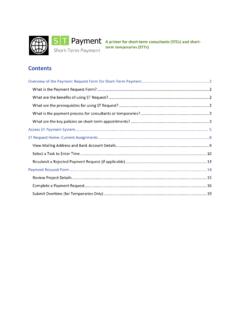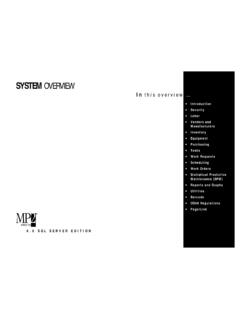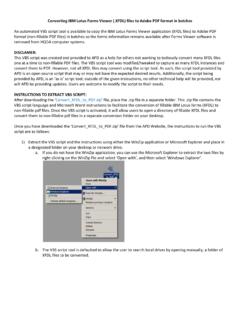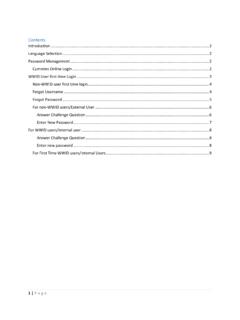Transcription of GCSE Maths Revision notes 2020/2021 - S-cool
1 GCSE Maths Revision notes 2020/2021 All copyright and publishing rights are owned by S-cool . First created in 2000 and updated in 2013, 2015 & 2020 1 Contents Approximations .. 3 Rounding .. 3 Percentages .. 4 Fractions .. 4 Decimals .. 4 Changing Between .. 4 Percentages .. 4 Indices .. 6 The 6 Rules .. 6 Standard Form .. 6 Indices in Algebra .. 6 Sequences .. 7 nth term .. 7 Angles .. 8 Bearings notes .. 8 Trigonometry .. 9 Pythagoras' Theorem .. 9 Measurement .. 11 Volume .. 11 Metric/Imperial .. 12 Lotus .. 13 Polygons and Circles .. 14 Special types of triangle .. 14 Transformations.
2 16 Similar shapes .. 16 Graphs .. 17 All copyright and publishing rights are owned by S-cool . First created in 2000 and updated in 2013, 2015 & 2020 2 Linear 17 Quadratic graphs .. 17 Cubic and reciprocal graphs .. 17 Graphs of simultaneous equations .. 18 Inequalities - regions on a graph .. 18 Travel graphs .. 18 Algebra - Equations and Inequalities .. 20 Linear Equations .. 20 Quadratic Equations .. 20 Rearranging Formulae .. 20 Simultaneous 21 Inequalities .. 21 Representing Data .. 22 Gathering data .. 22 Analysing Data .. 22 Pie charts .. 22 Cumulative Frequency .. 23 Scatter Diagrams.
3 24 Probability .. 25 Simple probability .. 25 Experimental probability .. 25 The 'and' rule .. 25 Tree diagrams .. 25 Calculator .. 26 Brackets and Memory .. 26 Powers and Roots .. 26 Standard Form .. 26 Fractions .. 26 All copyright and publishing rights are owned by S-cool . First created in 2000 and updated in 2013, 2015 & 20203 These notes cover the main areas of this subject. Please check the specific areas you need with your exam board. They are provided as is and S-cool do not guaranteed the suitability, accuracy or completeness of this content and S-cool will not be liable for any losses you may incur as a result of your use or non-use of this content.
4 By using these notes , you are accepting the standard terms and conditions of S-cool , as stated in the S-cool website ( ). Approximations Rounding Decimal Places - count from the decimal point Significant Figures from the first 't count zeros unless they're in-between non-zero one significant figure unless you can be more accurate and still do it in your is only real answer can be half the rounded unit either call them upper and lower values of calculations: and Multiplication - use all upper and Division - first number upper bound, second number lower versa for minimum values of calculations.
5 Trial and Improvement tables to display guesses and answers. Say whether too high or too low! you know which two numbers the answer is between try the middle and that will tell you which one it is copyright and publishing rights are owned by S-cool . First created in 2000 and updated in 2013, 2015 & 20204 Percentages Fractions Basic skills: Cancelling, improper to mixed numbers, multiplying, dividing, adding, subtracting. Always change mixed numbers to improper fractions before doing calculations! Finding fractions of quantities - multiply by the top, divide by the bottom. Ratio - find the total number of parts before dividing.
6 Decimals Basic skills: Adding, subtracting, multiplying, dividing. Changing Between Percentages To write an amount as a percentage: Finding a percentage of a quantity: the % to a decimal (divide by 100). by the original a quantity by a percentage: new percentage after increase/decrease (100 - % increase/decrease). it to a decimal (divide by 100).All copyright and publishing rights are owned by S-cool . First created in 2000 and updated in 2013, 2015 & 20205 by the original interest: interest on to 100%. to a decimal (divide by 100). the original amount by this decimal for each copyright and publishing rights are owned by S-cool .
7 First created in 2000 and updated in 2013, 2015 & 2020 6 Indices The 6 Rules 1. When you multiply powers of the same number you add the powers. 2. When you divide powers of the same number you subtract the powers. 3. When you put a power outside a bracket you multiply the powers. 4. Negative powers mean reciprocal or 'one ' 5. When the power is a fraction the top of the fraction is a power and the bottom of the fraction is a root. 6. Anything to the power of zero is simply equal to 1. Standard Form Any number can be written in the form a x 10n where a is a number between 1 and 10 and b is an integer.
8 Indices in Algebra Algebraic fractions can be simplified by following Rule 2 of Indices and taking the powers on the bottom away from the powers on the top or, in other words, cancelling the powers. All copyright and publishing rights are owned by S-cool . First created in 2000 and updated in 2013, 2015 & 20207 Sequences nth term nth term = dn + (a - d) where d is the difference and a is the first term. If the second difference is constant (and first difference changes), where a is the first term, d is the difference between the first and second terms and c is the second difference. Alternatively: the first difference keeps changing but the second difference is constant then the formula is something to dowith 'n2'.
9 Make a table showing the first few terms of 'n2'. the next column of your table write the differences between the term of 'n2' and your the formula for this new sequence using dn + (a - d) it on to n2 to give you your final formulaWell-known sequences Sequence Name nth term 2,4,6,8,.. Even numbers 2n 1,3,5,7,.. Odd numbers 2n - 1 1,4,9,16,25,.. Square numbers n2 1,8,27,64,125,.. Cube numbers n3 1,3,6,10,15,.. Triange numbers n(n + 1) 2,3,5,7,11,13,.. Prime numbers Not known All copyright and publishing rights are owned by S-cool . First created in 2000 and updated in 2013, 2015 & 20208 1,1,2,3,5,8,13.
10 Fibonacci numbers Not needed Angles Types of Angles What they Round a point Add up to 360o On a straight line Add up to 180o Vertically Opposite Equal In a triangle Add up to 180o In a quadrilateral (4-sided polygon) Add up to 360o Alternate (Z-angles) Equal Corresponding (F-angles) Equal Supplementary (C or U angles) Add up to 180o Bearings notes use three draw North measure from North being measure put in pencil lines connecting the points and don't rub them out at the put your protractor on the place you're measuring from and not as accurate as your can (sharp pencil, lean over diagram!)
















